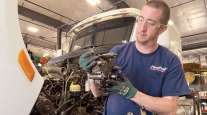Fleets Turning to Aftermarket for Parts, to Avoid Shortages, Find New Products
This story appears in the Jan. 28 print edition of Transport Topics.
LAS VEGAS — Fleet executives said they are turning to the aftermarket to avoid potential parts shortages and also are finding value in performing more maintenance in-house.
“Parts shortages have made us look for parts at places we otherwise wouldn’t have,” said Roy Svehla, senior manager of fleet maintenance for waste management company Republic Service, which operates 300 shops in 38 states.
Svehla made the comments during the Heavy Duty Aftermarket Dialogue here on Jan. 21, prior to the start of Heavy Duty Aftermarket Week.
He said Republic now buys 60% aftermarket parts and 40% original parts — a change from 10 years ago when 90% of parts were from the original equipment manufacturer.
“The aftermarket folks seem to be able to react quicker and introduce some innovative products that sometimes the OEs do not,” Svehla said.
He also said the aftermarket industry’s ordering systems for electronic parts are usually more advanced and easier to use.
Paul Higgins, director of fleet maintenance for Prime Inc., said he tries to find parts locally.
“There is something to be said for local availability. You can’t let a truck sit while you wait for the part,” he said.
Jon Cain, director of fuel services for Ahern Rentals, said that about 50% of his parts come from aftermarket vendors.
“We’re hesitant to try the non-OE parts sometimes,” he said, adding that when he does purchase them, it is typically from a local vendor who can provide them quickly.
Availability is vital for Cain, who has changed his warehousing strategy.
“I’ve tried to reduce our cost and overhead in having parts sit on a shelf and have parts brought in when we need them. Sometimes we have to change up what we would want or use because of availability,” he said.
Several executives also said they have ramped up their internal maintenance programs as a result of the government’s Compliance, Safety, Accountability program.
Higgins said customers are “not going to do business with someone who has an unfavorable CSA score,” so the carrier has taken on a “pit crew” mentality and will throw a maintenance crew on a tractor and trailer so it can get turned around quickly.
Prime performs what is “basically an annual inspection” on its tractors and trailers every 90 days, he said.
Drivers are more accountable under CSA, so they are paying more attention to lights, mud flaps and other maintenance issues than they did in the past, Higgins said.
While carriers pay attention to warranties, they said the overall value of the product is more important.
“The value of the piece that I purchase is offset by the number of times I have to do the job if the quality isn’t high enough for it to go in and work,” Cain said.
Svehla said he seeks out products that are made domestically.
“I’m finding that what it says on the box is less important than where it was manufactured. We’re seeing a lot of offshore important pieces that don’t measure up,” he said.
The executives have even found that parts are lasting longer, leading some to question the actual value of warranties.
“We go through a truck cycle and still have the same brakes,” Higgins said. “Who would have thought you could make it on the same set of brakes or the same clutch?”
Stuart MacKay, president of MacKay and Co., said that clutches in 2012 were being replaced at 369,000 miles compared with 171,000 miles in 1982. In 2012, brake blocks were replaced at 400,000 miles compared with 161,000 three decades earlier.
MacKay also estimated that about 75% of service labor hours are performed by the vehicle owner. For Prime, that figure is 80%, Higgins said.
“We know what the quality is going to be, and we have a good grip on the cost,” Higgins said.
The challenge for the industry is finding qualified mechanics.
“There are fewer and fewer people trying to break into the vocations or the trades,” Svehla said.
Republic Services has partnered with trade schools to cultivate relationships and also tried to identify a very structured career path for the technicians brought in.
Likewise, Higgins said Prime is reaching out to vocational and high schools, adding that the younger generation is well-equipped to handle the electronic diagnostics on today’s trucks.


